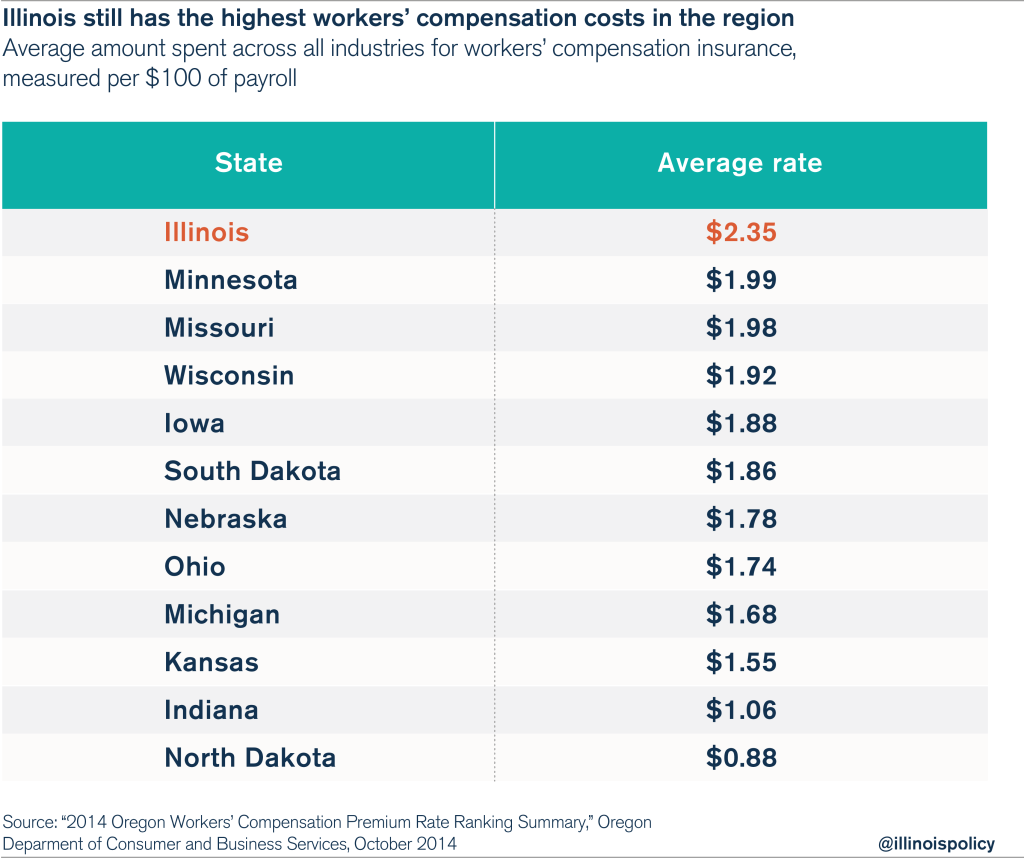Illinois still has the highest workers’ compensation costs in the region – by far
A new study reveals that Illinois has the highest workers’ compensation costs in the Midwest and the seventh highest in the United States.
Illinois manufacturers often pay as much as three times more in workers’ compensation costs than comparable businesses in Indiana. These businesses can save millions in workers’ compensation costs by moving just a few miles. Illinois’ workers’ compensation laws are harming workers and employers, and as a result, are hurting the Illinois budget by reducing the state’s tax base. A study from the state of Oregon confirmed that Illinois’ workers’ compensation costs are sky-high, especially compared to neighboring states.
Some have misinterpreted a study from the Workers Compensation Research Institute to mean that Illinois now has lower workers’ compensation costs than states such as Indiana and Wisconsin. This study found that some work-related medical costs in Illinois have come down as a result of changes made to Illinois’ workers’ compensation law in 2011, and some of these medical fees are now lower in Illinois than in Indiana and Wisconsin. But the reality is that Illinois still has the most costly workers’ compensation system in the region, and the seventh most costly in the U.S.
According to Eugene Keefe, a Chicago-based workers’ compensation attorney and adjunct professor of workers’ compensation law at The John Marshall Law School, workers’ compensation is composed of three benefits:
- Medical
- Lost time
- Permanency / impairment
While Illinois has saved some money on medical fees, the Land of Lincoln is still out of line with the rest of the Midwest on lost time and permanency and impairment costs. Illinois’ rates for lost time are much higher than Indiana’s and somewhat higher than Wisconsin’s. Illinois’ awards for permanency and impairment are dramatically higher than Indiana’s and moderately higher than Wisconsin’s. In other words, Illinois is not losing the race by as much, but it’s still losing the race.
The state of Oregon conducts a study every two years to compare workers’ compensation costs across states, measured as a percentage of payroll. Averaged across all industries, here’s how Illinois stacks up with other states as of 2014:
Businesses in Illinois still pay far more in workers’ compensation costs than businesses in any other state in the Midwest for the same types of workers doing the same kind of work. However, even the Oregon rankings don’t show the extent of the damage caused by Illinois’ flawed system, because most of this harm is clustered in a few of the riskier industries such as manufacturing, construction and transportation. In these industries, Illinois businesses pay two to five times as much for insurance compared to companies in neighboring states.
This is why when manufacturers such as Hoist Liftruck Manufacturing Inc. leave Illinois for Indiana, they say that Illinois’ broken workers’ compensation system is the main driver behind their decisions. The Illinois Policy Institute studied three occupations in each of the manufacturing, construction and transportation industries to compare how out-of-line Illinois’ costs are with those in bordering states and other states with which Illinois competes. The cost differences are surprising. For example, the average workers’ compensation-insurance premium for trucking (parcel and package delivery) is 23.6 percent of payroll.
The study from the Workers Compensation Research Institute showed that Illinois has made small gains as a result of its 2011 law. But focusing on those small gains ignores the major damage that Illinois’ workers’ compensation system is inflicting on industries such as manufacturing, where Illinois has lost 12,500 jobs in the first nine months of 2015, while its neighboring states have gained jobs. Illinois needs real reform to help both the businesses that pay these major regulatory costs, and the workers who keep losing their jobs to other states.


